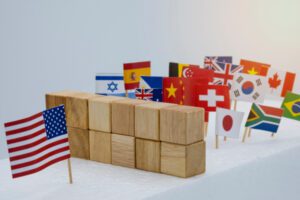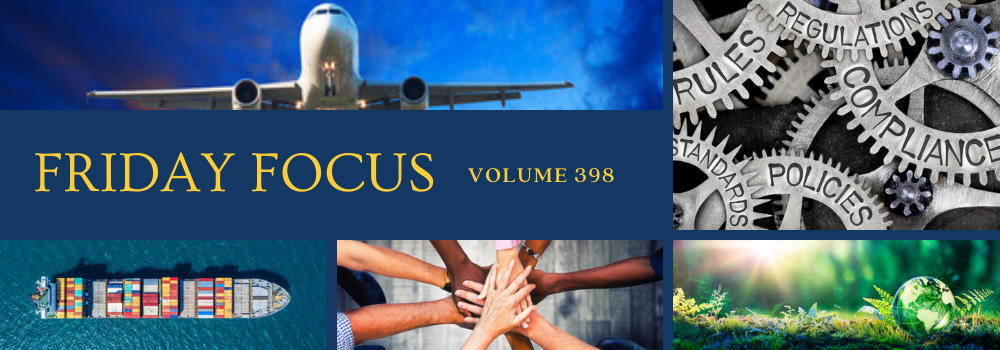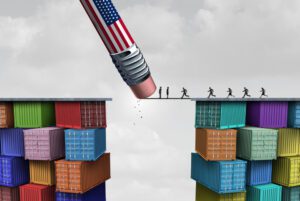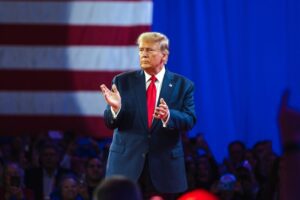Fiscal, Macroeconomic, and Price Estimates of Tariffs Under Both Non-Retaliation and Retaliation Scenarios
At several points over the course of the 2024 campaign, former President Trump has put forward a variety of different proposals for broadly raising tariffs across the board. A tariff is a tax on imports, generally levied at an ad valorem rate on the import’s customs value. Americans purchase imports directly as a part of final demand—such as when a consumer buys imported clothing at a retailer, or a business buys imported software—or as an input into the domestic production process, such as when a domestic auto manufacturer imports a key part. Tariffs, therefore, carry the potential to affect many different layers of the economy.
Like all tax policy, tariffs involve trade-offs, and they have both fiscal and macroeconomic implications. Unlike narrow, targeted tariffs, the broad tariffs of the magnitude proposed by President Trump have the potential to raise meaningful revenue over the budget window. However, these effects are uncertain and sensitive to key assumptions about the behavior of both US and foreign consumers, businesses, and governments.
President Trump’s proposals have also sparked a public debate about who bears the ultimate burden, or the incidence, of tariffs. This question is neither new nor broadly open in the forum of public finance and trade economics, however. A consistent theoretical and empirical finding in economics is that domestic consumers and domestic firms bear the burden of a tariff, not the foreign country.
This analysis’ purpose, therefore, is not to re-adjudicate the incidence question but to instead, from the standpoint of economic evidence, quantify the fiscal and macroeconomic effects of illustrative tariff proposals that capture the elements of various comments from President Trump.
|
|
|
|
This piece includes excerpts from Deborah Elms’ article “Trump and Trade, Part 1: How Trump Hardwired 21st Century US Trade Policy”.
Trade and economics are at the center of Trump’s agenda. His positions on many other topics have shifted over the years, but he has always been focused on trade. It is a polestar that predates his presidency. He took out a full-page advertisement in the New York Times in 1987 to protest what he saw then as unfair trade practices especially by Japan, which he viewed as crippling the US. He was already foreshadowing his later moves, as President, to impose higher tariffs.
Once he became President, trade policy became one of “four points of the Trump policy compass.” That trade compass has proven remarkably durable, with many of the changes he and his team made to US policies remaining in place even after he left the White House. Positions that the Trump administration took to reorient America’s long-term policymaking now appear to be “hardwired” into Washington’s decisions.
There are several points worth noting in assessing the sharp shift in US approaches to trade and economic policymaking that started under Trump and largely continued under Biden. These include
- driving trade policy from the White House and Executive Branch;
- renewed use of unilateral trade tools;
- reformulation of trade policy to fit an economic war;
- changing relationships with economic friends and allies;
- the conflation of trade and national security interests; and
- a diminution of the global trade system and multilateral rulemaking.
Trump’s effectiveness in implementing his trade agenda was assisted by a peculiarity of the US political system. While the US Constitution gives explicit powers to Congress to manage tax (and, by extension, tariffs), there is significant room for a US president and the executive branch to maneuver on trade and economic issues. From Trump’s first full day in office in January 2017, when he unilaterally withdrew the United States from the Trans-Pacific Partnership (TPP) agreement, US trade policy was largely driven from the Oval Office without much pushback from Congress.
Trade policy has continued to be run out of the Executive Branch under the Biden administration. Biden has, like Trump, issued a range of Executive Orders on trade and economic issues that bypass Congress. He has further centralized trade policymaking in the White House, with a much more limited role for the US Trade Representative’s (USTR) office. The US Commerce Department played a central role in the Indo-Pacific Economic Framework for Prosperity (IPEF), which required adjusting domestic US policy processes to allow Commerce to engage in international negotiations.
Second, Trump chose as his USTR a trade attorney and senior trade official in the Reagan administration, Robert Lighthizer, who has extensive knowledge and experience of the US political and policymaking system. Lighthizer, along with other advisors including Peter Navarro and to a lesser extent Wilbur Ross, was an architect of many US statutes and policies that had largely lain dormant for years or even decades. Once he was appointed USTR, Lighthizer was able to resurrect domestic tools such as Section 301 on unfair trade practices or Section 232 on national security.
Again, many of these specific tools have continued in use by the Biden administration. Section 232 tariffs imposed on steel and aluminum are still in place, as are Section 301 tariffs against Chinese products. Biden announced new a Section 232 application for steel by proclamation on July 20, 2024. Section 301 tariffs have also been imposed on a new set of Chinese products in August 2024.
|
Keynes’ Support for Broad Tariffs
|
As Great Britain (and the rest of the world) faced major employment and economic issues during the Great Depression, one solution proposed by John Maynard Keynes to boost employment was tariffs. In a 1931 essay, Keynes argued for “import duties of 15 per cent on all manufactured and semi-manufactured goods without exception, and of 5 percent on all foodstuffs and certain raw materials, whilst other raw materials would be exempt.” The explicit goal of these tariffs (as is the goal of tariffs today) is to not only increase revenue, but also increase the use of domestically manufactured goods, boosting the country’s production and employment. As Keynes puts it, “In so far as it [tariff policy] leads to the substitution of home-produced goods for goods previously imported, it will increase employment in this country.” Keynes also understood how the modern world economy was much different than the simpler world economy of classical free trade economics. Absolute and comparative advantage were novel ideas in David Ricardo’s world of making cloth and wine in England vs. Portugal, but it is a misleading oversimplification in today’s economy. In today’s world dominated by continuously advancing technology and large-scale manufacturing facilities, Keynes found that, “Experience accumulates to prove that most modern mass-production processes can be performed in most countries and climates with almost equal efficiency.” Moreover, Keynes also saw no major impact of such a tariff policy on prices or inflation. Regarding his tariff proposal, Keynes states, “I am prepared to maintain that the effect of such duties on the cost of living would be insignificant—no greater than the existing fluctuation between one month and another.” 10/28/2024 | Andrew Rechenberg | Coalition for a Prosperous America |
|
 |
Economists most often try to work with data (facts). For example, some have used data to estimate that certain tariffs proposed by former president Donald Trump would cost a typical US household more than $2,600 a year. Others have marshalled data to estimate that US economic growth would be slowed by Trump’s plans for tariffs and mass deportations of unauthorized immigrant workers and by his idea of allowing the president to have more influence over the Federal Reserve Board.
But there is no data to help evaluate some of Trump’s bigger but more vague tariff plans. Trump outlined his latest ideas in a recent appearance at the Economic Club of Chicago. He said that if he wins reelection, tariffs would be a major source of government revenue and would be used to:
- Retaliate against countries that are unfair traders.
- Rebalance trade with Europe and Japan, among others.
- Penalize American companies investing overseas if they plan to sell in the US market.
- Prevent would-be aggressor states from making war on their neighbors.
- Rebuild the American industrial base.
- Repair the US tax base.
- Cut the federal deficit.
Now here is where the estimating gets tough. The effects of Trump’s tariffs on the economy, on businesses, and on individual consumers and workers would literally be incalculable. Trump has told us of his tariffs’ many potential uses, but he left out details about how high they would be and how and when they would be applied. He has said that any tariff can be set at hundreds or a thousand percent. He clearly understands that if a tariff is high enough trade will cease, but that is a sacrifice that he sees as necessary to achieve his desired result. There is no upper limit. The assumption on which economists prepared their estimates was a 20 percent tariff on all imported goods, except goods from China that would bear a 60 percent tariff. But much more is being threatened by Trump than a blanket tariff at those levels.
There are those among Trump supporters, according to press reports, who say that the tariffs are mainly a negotiating ploy. But that is not what the former president is saying. If we are to take Trump at his word, there is no telling what tariffs there will be. A state of uncertainly may be good as a negotiating ploy in the private sector when buying or selling property, and sometimes maybe useful in extracting concessions from other governments in international negotiations, but widespread uncertainty in an economy would clearly be damaging to investment.
Nor are there clear answers as to what Trump would do with tariffs in a second term by looking to the extent of the legal authorities that Congress has given presidents.
The Constitution clearly gives the power over foreign commerce to the Congress, not the president. But the Congress has over time delegated much authority over tariffs to the president.
10/21/2024 | Alan Wm. Wolff | The Peterson Institute for International Economics





